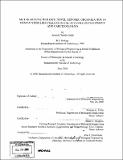Metakaryotic biology : novel genomic organization in human stem-like cells of fetal-juvenile development and carcinogenesis
Author(s)
Gruhl, Amanda Natalie
DownloadFull printable version (21.06Mb)
Other Contributors
Massachusetts Institute of Technology. Biological Engineering Division.
Advisor
William G. Thilly and Elena V. Gostjeva.
Terms of use
Metadata
Show full item recordAbstract
Eight distinct nuclear shapes, or morphologies, have been discovered in human proto-organs and tumors, including bell-shaped nuclei with stem-like properties. These bell-shaped, or "metakaryotic," nuclei are abundant in fetal tissues and neoplasias, but rare in normal adult somatic tissues. Metakaryotic nuclei employ an unusual process for division in which DNA synthesis, partial genomic condensation, and separation of the two nuclei in a cup-from-cup fashion occur concurrently, as shown by Feulgen densitometry and single-stranded DNA assays by Dr. Elena Gostjeva. This is clearly different from the sequential steps of S-phase DNA synthesis, chromatin condensation, chromosomal separation, and genomic segregation that occur in mitotic eukaryotic cells. In order to discover how a genome apparently devoid of chromosomes might be organized, this thesis focused on recognizable DNA sequences common to all chromosomes: centromeres and telomeres. Fluorescence In Situ Hybridization (FISH) with pan-centromeric and pan-telomeric probes was applied to samples of human tissue. (A collaborating lab used centromeric and telomeric antibodies to confirm results.) An optimized FISH protocol was developed specifically for metakaryotic nuclei and tested in both human cell lines and eukaryotic cells as experimental controls. Staining of metakaryotic nuclei resulted in approximately 23 centromeric regions in each, unlike the expected number of 46 regions seen in eukaryotic nuclei. Many of these staining regions contained paired centromere signals, or doublets. This suggested a genomic organization of homologous chromosomes paired at their centromere regions. If this were the case, one would expect 46 telomeric signals per nuclei, if telomeres were also homologously paired. (cont.) Unexpectedly, an average of 23 telomeric regions were found in many, if not all, bell-shaped metakaryotic nuclei. This, along with the observation of a condensed double ring around the mouth of the bell-shaped nuclei, suggested the possibility of a genome organized as paired, continuous genomic circles. Studies of telomere joining in metakaryotic nuclei by Dr. Per Olaf Ekstrom have provided further evidence for the paired genomic circle model. The results in this thesis are an original contribution to the field of stem cell physiology, a starting point for further investigation of DNA organization, synthesis, and repair in these metakaryotic cells, and hopefully will lead to a greater understanding of human development, growth, and cancer.
Description
Thesis (Ph. D.)--Massachusetts Institute of Technology, Biological Engineering Division, 2008. Includes bibliographical references (leaves 66-75).
Date issued
2008Department
Massachusetts Institute of Technology. Department of Biological EngineeringPublisher
Massachusetts Institute of Technology
Keywords
Biological Engineering Division.